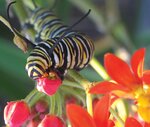It’s really here. Spring has finally settled in. Despite some recent chill, the welcome warmth of spring is drawing us outdoors again.
This item is available in full to subscribers.
We have recently launched a new and improved website. To continue reading, you will need to either log into your subscriber account, or purchase a new subscription.
If you are a digital subscriber with an active subscription, then you already have an account here. Just reset your password if you've not yet logged in to your account on this new site.
If you are a current print subscriber, you can set up a free website account by clicking here.
Otherwise, click here to view your options for subscribing.
Please log in to continue |

It’s really here. Spring has finally settled in. Despite some recent, and unseasonable, frost – what poet Emily Dickinson called “the blond assassin,” that can chill and cripple our flower beds – the welcome warmth of spring is drawing us outdoors again, where we can enjoy successive waves of color, texture and tantalizing natural fragrances.
And what better place to enjoy the sensual pleasures of spring than in our very own gardens. It’s the quality of the air. The successive waves of forsythia, dogwood blossoms and azaleas. The quietude. The counterpoint we need to the sometimes-teeming world beyond.
According to Bill Cullina, executive director of Morris Arboretum & Gardens of the University of Pennsylvania, “Judging from the booming nursery business, more homeowners are having fun in their own gardens these days.” They are looking at their own back yards as a haven to relax from the pressures of the workaday world.
“And now that we’ve added ‘Gardens’ to our name,” he continued, “we’ve begun planting a pop-up garden of 10,000 annual flowers we’re calling ‘Exuberant Blooms.’ Check back later in the summer to see it in full bloom. And many of these flowers are especially good for pollinators.”
Pollinators are insects or birds that carry pollen to a plant to allow fertilization. According to Cullina, 75 percent of flowering plants depend upon these pollinators – like bees, butterflies and hummingbirds – to carry out the work of fertilization for the next generation.
So pollinator gardens not only provide homeowners with sensual pleasure, they also play a pivotal role for the environment. If you’re planting one, your best bet is a sunny spot that you can keep moist where these plants can thrive and attract those hard-working pollinators.
Bees are especially attracted to, and benefit from, pollinator gardens, including the more than 400 species of bees native to Pennsylvania, many of which are in danger of extinction. But have no fear. Honeybees are thriving as never before. And other species of bees, according to Cullina, “are not aggressive. They’re too busy pollinating. It’s the wasps and hornets you have to look out for. They’re looking for insects to kill,” so don’t get in their way.
Besides these basically placid bees, your pollinator garden will also draw butterflies and moths that are especially attracted to colorful flowers, perhaps a mix of perennials and annuals. Among their favorite landing spots are asters, daisies, zinnias, coleus, black-eyed Susan and marigolds.
They also like to visit plants in the mint family, like rosemary, lavender, lemon balm, giant hyssop, wild bergamot, sage, and thyme. Hummingbirds are especially drawn to intense, brightly colored flowers – blue, purple, and red – like bee balm and cardinal flowers, ornamental sage and Mexican sunflowers, the latter of which are readily available at this time of year.
Swallowtail butterflies love dill, phlox, zinnias, and milkweed. American Lady butterflies feast on the nectar of plants in the sunflower family, as well as asters, pussytoes, everlasting, and ironweed. The Painted Lady prefers to feed on the blazing star, purple coneflower, zinnias, and Mexican sunflower. The glorious, cherished Monarch feeds exclusively on milkweed, the only host plant for this iconic species.
Their caterpillars thrive on milkweed leaves. But caterpillars also love to dine on pussy willow pollen in the spring. They are especially attracted to the Black Knight bush or aptly named butterfly bush, especially the Nanho blue, purple, indigo, pink beauty, royal red or white profusion types. After they emerge from their cocoons, they’ll adopt your garden as their home. But they won’t come to any old garden. Butterflies have an aversion to any place where pesticides and other chemicals are in the soil.
So how else can you let your garden grow? Container growing is also quite popular. Cullina recommends that your pot be at least 12 inches in diameter, and the bigger, the better. Whiskey barrels make especially good containers. But be sure to poke holes in the bottom for proper drainage.
Copper pots are not recommended, as they are toxic to plants. Galvanized zinc washtubs are a fine alternative, or fiberglass containers. Be sure to buy soil that’s appropriate for your container, and don’t forget to fertilize your plants. Your local nursery can help you here.
Another suggestion, to attract those non-stinging native bees (which includes most of them, like the mud bee), is to set up hollow stems or bamboo, or to make holes in blocks of wood and hang them up horizontally.
And don’t forget to arrange plenty of chairs, benches and gliders in order to sit down to enjoy your garden and its winged visitors from different perspectives. There’s nothing like rocking in a womb-like glider, watching a breeze blowing through a bed of butterfly-friendly daylilies or verbena, or catching a whiff of fragrant hostas behind you as you gaze at the panoply of wildflowers at your feet.
And because butterflies hover or fly so slowly, children and elderly people take special delight in watching them up closely. Your own personal garden, personalized as you like it, is the perfect place to enjoy a moment’s relaxation, to relieve the stress of the day and fill yourself with the blossoming, and fluttering, wonders of the outdoors just outside your door.